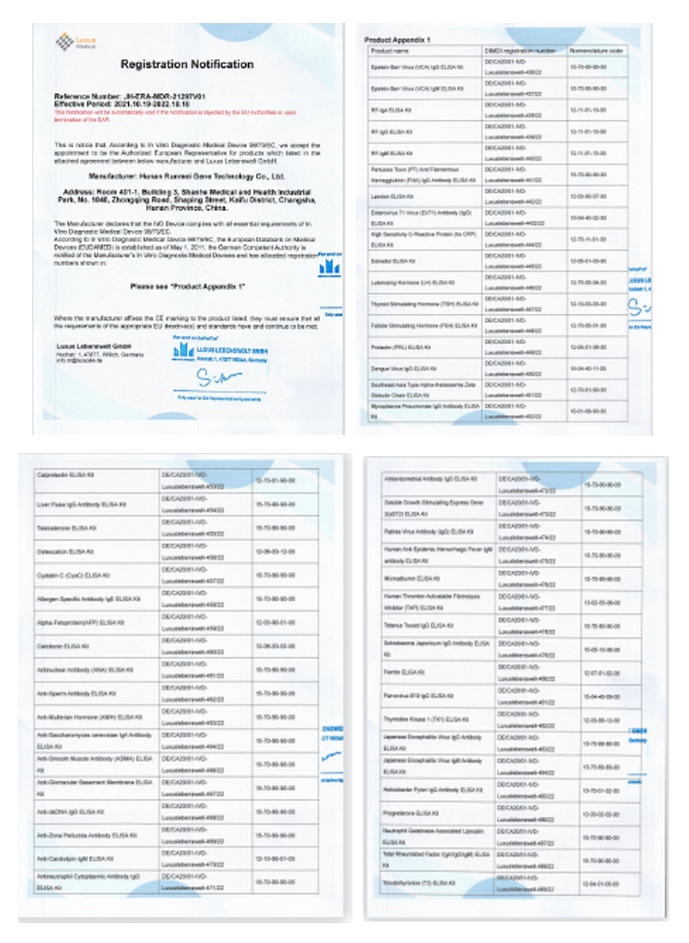Principle:
In 1971, Engvall and Perlmann published an article on the quantitative determination of IgG using enzyme-linked immunosorbent assay (ELISA), which made the enzyme-labeled antibody technology used for antigen localization developed in 1966 to develop into trace substances in liquid samples method of determination.The basic principle of this method is: ① Make antigen or antibody bind to the surface of a certain solid phase carrier and maintain its immunological activity.② The antigen or antibody is linked with a certain enzyme to form an enzyme-labeled antigen or antibody, which retains both its immune activity and the activity of the enzyme.During the determination, the test sample (the antibody or antigen in it) and the enzyme-labeled antigen or antibody are reacted with the antigen or antibody on the surface of the solid phase carrier according to different steps.The antigen-antibody complex formed on the solid-phase carrier is separated from other substances by the washing method, and the amount of enzyme bound to the solid-phase carrier is proportional to the amount of the tested substance in the specimen.After adding the substrate of the enzyme reaction, the substrate is catalyzed by the enzyme into a colored product, and the amount of the product is directly related to the amount of the tested substance in the sample, so it can be qualitatively or quantitatively analyzed according to the depth of the color reaction. Due to the high catalytic efficiency of the enzyme, the reaction effect can be greatly amplified, so that the assay method can achieve high sensitivity.
Progressive
Avidin is a glycoprotein, and one molecule of avidin can have a specific affinity with four biotin small molecules, similar to the affinity of antigen and antibody.The force between them is the strongest known non-covalent interaction.After the 1980s, with the discovery of the biotin-avidin system (BAS), this affinity was applied to ELISA technology, which greatly improved the sensitivity and specificity of the latter reaction.Biotin is easily covalently bound to proteins (such as antibodies, etc.).In this way, the avidin molecule combined with the enzyme reacts with the biotin molecule combined with the specific antibody, which not only plays a multi-stage amplification effect, but also changes color due to the catalytic effect of the enzyme when it encounters the corresponding substrate, achieving detection. The purpose of the unknown antigen (or antibody) molecule.
Result Judgment
1.Qualitative Determination
The result judgment of qualitative measurement is to give a simple answer of "yes" or "no" to whether the tested sample contains the antigen or antibody to be tested, which is expressed as "positive" and "negative" respectively."Positive" indicates that the specimen responded to the assay system."Negative" means no response.The semi-quantitative results can also be obtained by the qualitative judgment method, that is, the titer is used to express the intensity of the reaction, and its essence is still a qualitative test.In this semi-quantitative assay, the sample is tested after a series of dilutions, and the highest dilution that gives a positive reaction is the titer.According to the titer, the reactivity of the sample can be judged, which is more quantitatively meaningful than judging the strong positive and weak positive by observing the color depth of the undiluted sample.In indirect and sandwich ELISA, positive wells were darker than negative wells.In a competitive ELISA, on the contrary, negative wells are darker than positive wells.
2. Quantitative determination
ELISA has complicated operation steps and many factors that affect the reaction. In particular, the coating of solid-phase carrier is difficult to achieve consistency between individuals. Therefore, in quantitative determination, a series of reference standards with different concentrations must be used for each batch of tests. A standard curve was made under the same conditions.Sandwich ELISA for the determination of large molecular weight substances, the range of the standard curve is generally wide, and the absorbance at the highest point of the curve can be close to 2.0. The semi-log value is often used for drawing, taking the concentration of the test substance as the abscissa and the absorbance as the ordinate. The concentration values are connected point by point, and the obtained curve is generally S-shaped, the head and tail curves tend to be flat, and the central part that is more straight is the most ideal detection area.Competitive method is commonly used for determination of small molecular weight substances, and the absorbance in the standard curve is negatively correlated with the concentration of the tested substance.The shape of the standard curve varies slightly depending on the mode used in the kit.Note that the abscissa in the standard curve of the ELISA assay is a logarithmic relationship, which is more conducive to the expression of the assay system.
A variety of ELISA kits developed by Hunan Runmei Gene Technology Co., Ltd. have obtained EU CE certification. The list is as follows. They are used by inspection laboratories, professional medical institutions, WHO, customs, police stations and other departments around the world.



